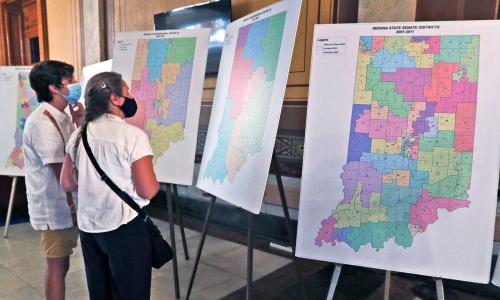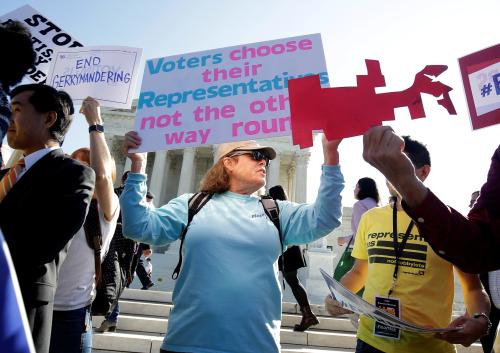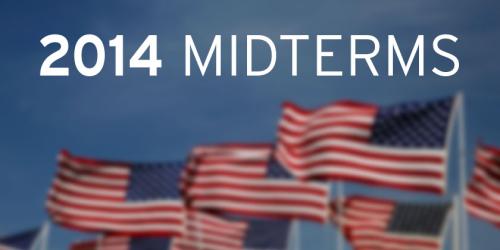Last November revealed the capstone of misrepresentation in American democracy when Hillary Clinton won the popular vote by 2.9 million votes but lost in the Electoral College.
But what about the U.S. Congress? How representative of the American people is the House of Representatives? My Brookings colleague Molly Reynolds finds the Republican Party’s current “seat bonus”—a higher percentage of seats than of votes—aligns with the historic advantage for any majority party in the House over the last 70 years, back to 1946.
This post focuses on how representative the new 115th Congress is on a state-by-state level.
Majority party over-represented
Despite its name, the House of Representatives is not so representative.
As the chart below shows, the total vote differential between the two parties for elections to the House in 2016 was 1.2 percent. But the difference in the number of seats is 10.8 percent, giving a total of 21 extra seats to Republicans.
Figure 1: National Distribution of Votes for Congress
| NUMBER | PERCENTAGE | |||
| Party | Republican | Democrat | Republican | Democrat |
| Votes | 63,164,365 | 61,750,858 | 50.6% | 49.4% |
| Seats | 241 | 194 | 55.4% | 44.6% |
| “Misrepresented Seats” | 21 | -21 | 4.8% | -4.8 |
Over-representation by state
This aggregate over-representation of the majority party is considerably extreme when looked at state-by-state. In red states (see Figure 2), Republicans garnered 56 percent of the vote but 74.6 percent of representation. In blue states, Democrats won 60.3 percent of the vote but 69.1 percent of representation.
Almost all states are “true”—“true red states” have a Republican majority of votes and representation; “true blue states” have a Democratic majority of votes and representation. Two states are “flipped blue states;”in Virginia and Wisconsin Republicans received a majority of seats despite Democrats winning a majority of the votes for Congress.
Misrepresentation is considerably larger within each red and blue grouping than in the U.S. as a whole. Translated into seats in the House, Democrats over-represent blue states (excluding the two flipped states) by 19 seats, whereas Republicans over-represent true red and flipped blue states by 40 seats. Republicans over-represent red states (true and flipped) by 16 percentage points, while in united blue states the disparity is 11 percentage points.
Figure 2: Majority Party Wins Disproportionate Representation

Misrepresentation in small and large states
For individual states, misrepresentation is even larger. The level of misrepresentation is 20 percent or greater in 23 states—almost half the country—and over 30 percent in 12 states.
To a certain extent, misrepresentation is partly a function of state size. In small states with a single member—Alaska, Delaware, Montana, North Dakota, South Dakota, Vermont, and Wyoming—there is no alternative to the votes of a portion of the citizens not being represented. In these states, on average, 37 percent of voters selected the losing party. Even states with two representatives—New Hampshire, Rhode Island, Hawaii, Maine, and Idaho—have a large degree of misrepresentation, on average 28 percent. This is not surprising in a winner-take-all system. Overall, the misrepresentation from these small states cancels out in the aggregate—in the 17 seats of these states there is only a 3 percentage point disparity between the distribution of votes and the distribution of seats.
On the other extreme are the four largest states—New York, Florida, Texas, and California. Together, these states send 143 representatives to Congress. Each has less than 10 percent misrepresentation—votes from the losing party in one district are compensated in other districts. Moreover, the overall distribution from these states is the storybook picture of democracy at work: Between them, the distribution of votes and seats was equal, with less than 1 percent difference between votes and representation (45 percent for Republicans, 55 for Democrats).
Figure 3: Misrepresentation in Small and Large States 2016
 Note: The level of misrepresentation is computed as the difference between percent of votes and percent of seats.
Note: The level of misrepresentation is computed as the difference between percent of votes and percent of seats.
Misrepresentation in midsized states
That leaves the 34 midsized states, with 275 seats among them, to account for the observed misrepresentation. Figure 4 plots the number of seats from each state against the level of misrepresentation. Large and small states are gray; midsized states are red. In general there is an inverse correlation between the number of representatives from a state and the level of misrepresentation. States with three to five representatives range between 11 to 36 percentage points of misrepresentation, while those with 10-20 representatives range from 4 to 24 percentage points of misrepresentation.
Figure 4: Number of Seats in Congress Compared to Level of Representation

Figure 5 below shows the level of misrepresentation in the 34 midsized states, ranked in order of the level of misrepresentation with blue and red states shown separately. This figure shows the quite large level of disproportionate representation in many states. Out of the 34, more than one-third (13) have a disparity between votes and representation of 20 percent or larger, and in all but five states the disparity is greater than 10 percent.
Midsized red states have on average a considerably higher percent level of misrepresentation—in these states, while 58 percent of the votes went to Republicans, they took 76 percent of the seats—an 18 percentage point difference that translates into 34 seats. Comparatively, in the midsized blue states, 59 percent of votes were for Democrats, who obtained 72 percent of seats—a 13 percentage point difference that translates into 11 seats. Furthermore, red states make up nine of the 13 states with an excess of 20 points or higher misrepresentation.
Figure 5: Misrepresentation in Midsized States in 2016
 Note: Level of misrepresentation computed as the difference between percent of votes and percent of seats.
Note: Level of misrepresentation computed as the difference between percent of votes and percent of seats.
Redistricting
What is underlying this outcome? In principle, such results are possible even if most of the state is competitive, but one party has an edge in the majority of the districts. In practice, how districts are drawn can also affect outcomes. In fact, some states have moved to take redistricting away from elected state politicians by instituting independent redistricting commissions. The four large states that have independent commissions—California, New Jersey, Washington, and Arizona—have less than 10 percent misrepresentation. The two other states with independent commissions, Idaho, and Montana, with two and one congressional representatives respectively, have greater than 30 percent misrepresentation. There is no getting around size!
Overrepresentation by number of seats per state
As to states with the most number of “extra” seats, Democrats dominate in California, with almost five addition seats. Republicans have approximately three extra seats in Texas, Ohio, Pennsylvania, and North Carolina.
Figure 6: Over-representation of Majority Party
 Note: Measured in congressional seats (compared with distribution of the votes).
Note: Measured in congressional seats (compared with distribution of the votes).
Implications
The independence of the U.S. was launched by a revolt over the lack of representation. Misrepresentation can lead to social and economic policy distortions, feed distrust, and drive discontent in government. Gerrymandering hinders party competition and the resulting political monopoly feeds extremism in the majority party. The edge provided by this misrepresentation gives the majority party disproportionate power that is particularly destabilizing and dangerous in an era of heightened polarization and partisanship.
The data suggest that the most serious problem is in midsized states, a problem that could be alleviated by the design of districts by independent bodies.






Commentary
Misrepresentation in the House of Representatives
February 22, 2017